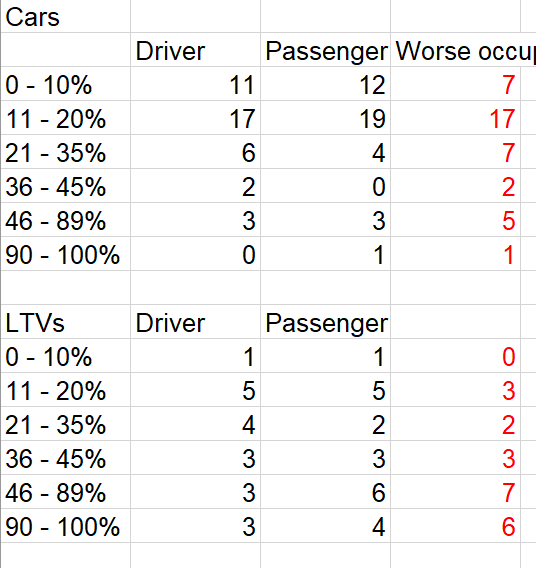NHTSA 30 MPH Crash Tests, 1977-1979: Cars vs. LTVs

Back in 2012 I posted about a series of 30-mph crash tests that NHTSA did in 1978-1979 on 1978 model vehicles. In the 9 years since, I have discovered more 30-mph tests done in the era. This analysis covers the results of 60 vehicles; 39 cars and 21 trucks, vans, and SUVs (LTVs). The cars were tested in the 1977 and 1978 model years, the trucks, vans, and SUVs as 1978 and 1979 models.
Overall, a majority of cars (not LTVs) of the late 1970s were able to provide adequate protection in a 30-mph full-frontal barrier crash, with an average severe injury risk of 20% to the drivers and 19% to the passengers – equivalent to a low-end 4 star rating for each occupant under the 1979-2010 NHTSA rating system. A majority of cars (24 out of 39) exposed both of their occupants to a risk of 20% or less, and only one occupant – the front passenger of a 1978 Mazda RX-4 – would have been likely to suffer fatal injury.
For LTVs, the average risks were 44% for the drivers and 51% for the passengers – equivalent to a low-end 2 star rating for drivers and a 1 star rating for passengers. 6 of the 19 LTVs showed a likelihood of fatality for at least one occupant.
Keep in mind that because those tests were done at 35 mph, not 30, results are not directly comparable. A 35-mph crash has 36% more force. As such, the average severe injury risk rose to about 45% for drivers and 45% for passengers of 1979-1980 cars (not LTVs) in 35-mph testing – a borderline 1 to 2 star performance for each occupant. LTV’s weren’t tested in the 35 mph test until 1983 – averaging about a 60% risk for each occupant from 1983-1985, placing them firmly in the 1 star range on average. By that time, there had already been substantial safety improvements in the LTV fleet compared to the 1978-1979 period.
The table provides injury risk ranges that correspond to the ranges of each star rating – i.e. 0-10% is 5 stars, 11-20% is 4 stars, and so on. I have also provided an additional range – 90-100% – that signifies that fatality would be likely. Due to data failure for some LTVs – on two drivers – there are only 19 driver results listed, compared to the full 21 passenger results.
The average “worse occupant” rating was 25% for cars and 63% for LTVs. “Worse occupant” simply takes the worse of the two occupants – for instance, if a vehicle had a 30% risk for driver and 15% risk for passenger, this number would be 30%. Similarly, if it were, say, 10% for driver and 20% for passenger, the number would be 20%. This is useful because a vehicle with a low “worse occupant” risk protected both occupants well, whereas a vehicle with a high “worse occupant” risk may have protected one OR both occupants poorly.







